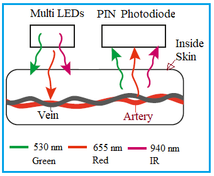Oxygen Concentrators: Advantages and Disadvantages for COVID-19
This article discusses the benefits and drawbacks of using oxygen concentrators for managing COVID-19 and similar respiratory illnesses.
Introduction
Ideally, a person’s blood oxygen level (SpO2) should be 95% or higher, typically ranging from 94% to 99%. SpO2 indicates the percentage of oxygen in the blood relative to its maximum carrying capacity. A pulse oximeter measures SpO2.
Lung diseases, like COVID-19, can cause SpO2 levels to drop. If SpO2 falls below 90%, it can strain the heart, lungs, and liver, necessitating medical consultation or hospitalization.
Here are ways to increase oxygen intake:
- Use an oxygen concentrator to get fresh air.
- Drink enough water.
- Consume iron-rich foods such as eggs, poultry, seafood, red meat, beans, dark green leafy vegetables, dried fruits, peas, and breads.
- Practice breathing exercises.

Figure-1: SpO2 measurement using pulse oximeter
SpO2 Levels in Various Conditions
The following table outlines SpO2 levels under different health conditions:
Table 1: SpO2 Levels by Condition
| Condition | SpO2 Level |
|---|---|
| Healthy individuals | More than or equal to 95% |
| People with COPD (Chronic obstructive pulmonary disease) | 88 to 92% |
| Hypoxic (low oxygen in tissues) | 85 to 94% (initiate oxygen therapy) |
| Severely Hypoxic | Less than 85% (administer supplemental oxygen immediately) |
SpO2 Levels by Age Group
SpO2 levels can vary with age, as shown in the following table:
Table 2: SpO2 Levels by Age Group
| Age group in years | Minimum SpO2 (%) | Maximum SpO2 (%) | Mean SpO2 (%) | Median SpO2 (%) |
|---|---|---|---|---|
| 18-24 | 80 | 100 | 98 | 98 |
| 25-34 | 82 | 100 | 97.6 | 98 |
| 35-44 | 73 | 100 | 97.2 | 98 |
| 45-54 | 76 | 100 | 96.8 | 97 |
| 55-64 | 72 | 100 | 96.3 | 97 |
| >=65 | 70 | 100 | 95.8 | 96 |
Fluctuations or a continuous decrease in SpO2, as measured by a pulse oximeter, warrant consultation with a doctor or health expert. Tests are needed to determine whether SpO2 changes are due to COVID-19 or another illness. Patience and maintaining a positive attitude are crucial while awaiting test results.
What is an Oxygen Concentrator?
An oxygen concentrator is a device that delivers pure, medical-grade oxygen, beneficial for people with low blood oxygen levels. It works by concentrating surrounding air and providing fresh, pure oxygen to help patients breathe more easily. It serves as an alternative to compressed gas containers or portable oxygen cylinders, eliminating the need for refills and providing a stationary oxygen source for COVID-19 patients and others requiring oxygen therapy.
How an Oxygen Concentrator Works
Oxygen concentrators function similarly to air conditioning units:
- Air intake from the surrounding environment.
- The inhaled air is compressed, and a cooling system prevents overheating.
- Nitrogen is removed from the air using sieve beds and filters.
- Fresh oxygen is delivered through a mask or nasal cannula.
- The oxygen level output is controlled via an electronic interface on the machine.

Figure-2: Oxygen Concentrator (EVOX Model)
Technical Features (EVOX-5S)
Here are the technical specifications of the EVOX-5S oxygen concentrator, marketed by EVIDENT HEALTHCARE Mohali in INDIA:
- Smart touch panel with large LED display showing O2 purity.
- Includes nebulizer functionality as a separate outlet.
- Oxygen parameters:
- Oxygen flow: 0.5 to 5 L/min
- Oxygen concentration: 93% + 3%
- Oxygen output pressure: 0.04 - 0.07 Mpa
- Accessories: Nebulize nozzle and mask.
- Indicators and alarms for various parameters.
EVIDENT HEALTHCARE Contact:
- Address: Plot no. EL635 Phase-9 industrial Area (Mohali), INDIA
- Email: contact.esspee@gmail.com
- Phone: 9780392147, 7526961010
For a list of Oxygen Concentrator Manufacturers or Suppliers across INDIA, USA and other countries, refer to online directories.
Benefits (Advantages) of Oxygen Concentrators
- Portable and lightweight.
- Designed for low noise operation.
- Energy-efficient, saving power and reducing electricity bills.
- Reduces the need for frequent hospital visits for oxygen therapy, saving time and money.
- Minimizes exposure to infectious diseases like COVID-19 by enabling home use.
- Delivers continuous oxygen as long as power is available, unlike oxygen cylinders.
- Offers good portability compared to large oxygen cylinders.
- Provides good reliability, depending on the manufacturer and model.
- Improves survival rates in respiratory conditions, mental attentiveness, and patient mood.
Drawbacks (Disadvantages) of Oxygen Concentrators
- High initial capital cost and potentially higher running costs if electricity charges are high.
- Requires considerable training to operate compared to oxygen cylinders.
- Requires electricity for operation.
- Needs regular maintenance and technical repairs.
- May not be as physically robust as oxygen cylinders.
 RF
RF



